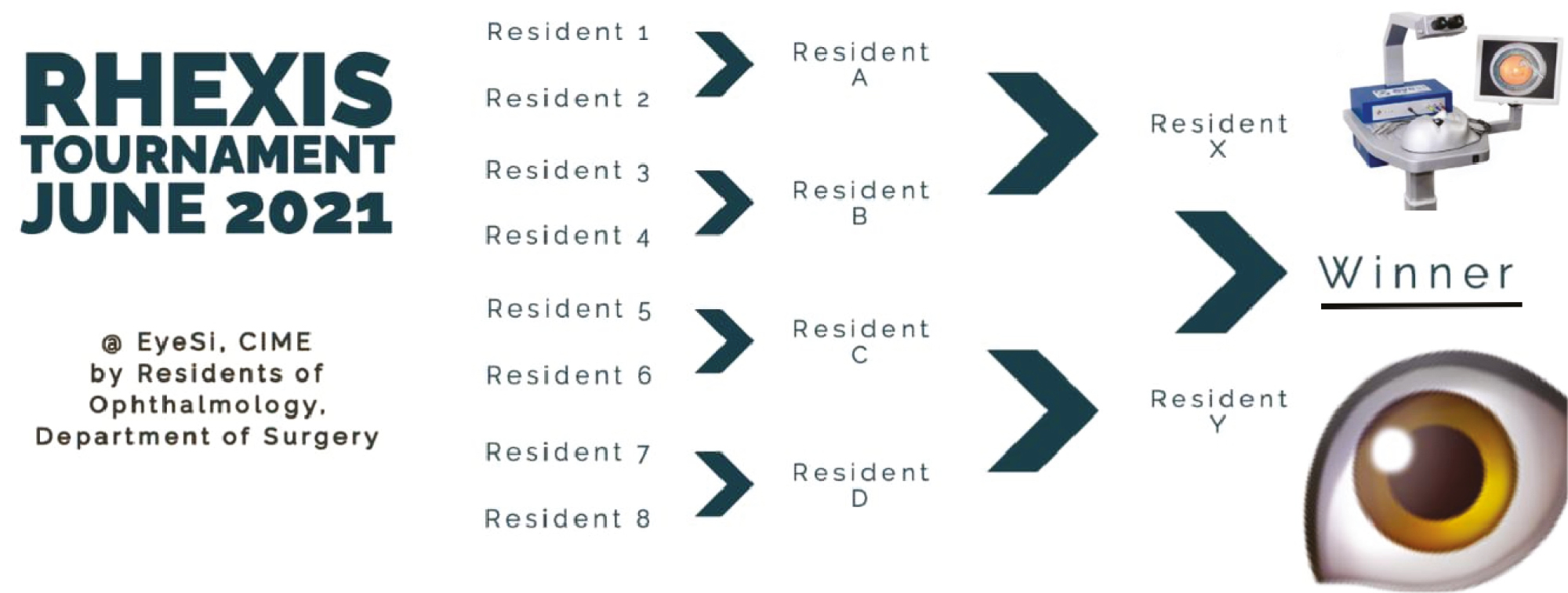
Recent advances in simulation have yielded great outcomes in training ophthalmology residents worldwide [1]. However, repetitive tasks may lead to burnout and loss of interest. The safe learning environments provided by surgical simulation create space for exploring creative practices and the introduction of gamification [2]. We held one such tournament for ophthalmology residents to compare and compete on their cataract surgery skills [3]. The aim was to generate interest and sportsmanship amongst the residents, and engage senior surgeons on the utility of simulation.
We designed a knockout tournament with 3 rounds, for 8 participants (Figure 1). Specific tasks for each round were selected on the EyeSi course software (V3.0.6). Round 1 was ‘Capsulorhexis-high tension’, round 2 ‘Capsulorhexis-errant tear’, and round 3 ‘Milky-White Cataract’. Rules were displayed to the participants before the event and the highest score of three consecutive attempts was considered a passing score. A live performance was projected on a screen with an audience, along with a scoreboard display keeping track of scores and progression of participants.


Round 1 scores for the 8 participants ranged from 0 to 94 out of 100, and the top 4 scorers who qualified for the next round scored 94, 94, 94, and 90 in their highest scoring attempt. The mean time taken per task in round 1 was 2 min 24 sec. Round 2 highest scores were 89, 86, 79, and 74, and the mean time taken was 2 min 18 sec. Final round 3 scores were 69 and 65, and a champion was declared. The whole event took 3 hours and successfully generated sportsmanship spirit and significant interest in surgical simulation. Furthermore, the simulator noted a total injured corneal area of 18.78 mm2 and capsular damage of 4.7 mm.
The design of the tournament not only ensured excitement amongst all participants but also encouraged participants to excel in the tasks in the provided course by bringing sportsman spirit, boosting the confidence of performing live surgery in front of an audience, and by collecting and analyzing their cumulative data. Gamification of surgical simulation allows residents to compete in a safe learning environment. We recommend this exercise to all centers equipped with surgical simulators. In the future, different surgical themes and future international tournaments may be explored.
1. Ahmed TM, Hussain B, Siddiqui MAR. Can simulators be applied to improve cataract surgery training: a systematic review. BMJ Open Ophthalmology. 2020;5(1):e000488.
2. van Gaalen AEJ, Brouwer J, Schönrock-Adema J, Bouwkamp-Timmer T, Jaarsma ADC, Georgiadis JR. Gamification of health professions education: a systematic review. Advances in Health Sciences Education. 2021;26(2):683–711.
3. Aga Khan University. EyeSurg Tournament. https://www.aku.edu/news/pages/News_Details.aspx?nid=NEWS-002602 [Accessed on 19/06/2022]